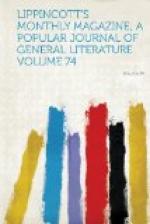at first sight, but we had a little of everything.”
It was in an elevated plain about fifteen miles in
diameter and nearly circular, girt by a circus of
hills rising fifteen hundred feet above the general
level. A trout stream ran through the property.
There were pretty estates around of about two hundred
acres each, with houses in general of modest dimensions
and architecture, though occasionally aspiring to
the dignity of chateaux. Roman and mediaeval remains,
with architecture of different periods, were to be
found in the city, as well as a public library and
art-gallery, cafes and the inevitable cercle.
The flora, owing to the diversities of elevation,
was varied, and while vineyards clothed the foot of
the slopes and gigantic old chestnuts looked down
on them from above, the vegetation of the hill-tops
was that of Lancashire or Scotland. It follows,
of course, that the pursuits and habits of the population
were correspondingly various, and there was ample
opportunity for studying the different classes of
society, from the noblesse to the peasants. The
results of this study are presented, not in the form
of labored analyses, but in easy and flowing sketches,
sometimes in the form of narrative, always full of
illustrative details, and winning without much discussion
or argument a ready assent to the author’s conclusions.
Many statements in the book will, of course, not be
new to generally well-informed readers, but it is
not often that they come with the same force and freshness
from direct observation, and still more rarely is their
relation to each other or their bearing on the subject
to which they relate so clearly and correctly indicated.
Among the points on which Mr. Hamerton has thus thrown
a stronger light are the characteristics and position
of French ladies, divided, “in this part of the
world,” he writes, “into two distinct
classes: the home women and the visiting women—les
femmes d’interieur, and les femmes du
monde; the exact theory of the mariage de convenance,
which is popularly but wrongly considered as based
on mere mercenary motives; and the mental condition
of the peasant, with his natural quickness of intellect
and his stupendous ignorance, his adherence to tradition
and ingrained superstitiousness, and his suspicion
of the nobles and tendency to emancipate himself from
clerical influence. It is France in a state of
transition that Mr. Hamerton paints, and his anticipations
have already to some extent been justified by events.
“My hope for France is,” he says, “that
a system of regularly-working representative government
may be the final result of the long and eventful revolution,
and that this form of government may give the country
certain measures which it very greatly needs.
A thorough system of national education is one of
them, a real religious equality is another. These
would never be conceded by a French monarchy of any
type with which past experience has made the country
familiar.... The only chance of real representation
lies in the Republic.”




